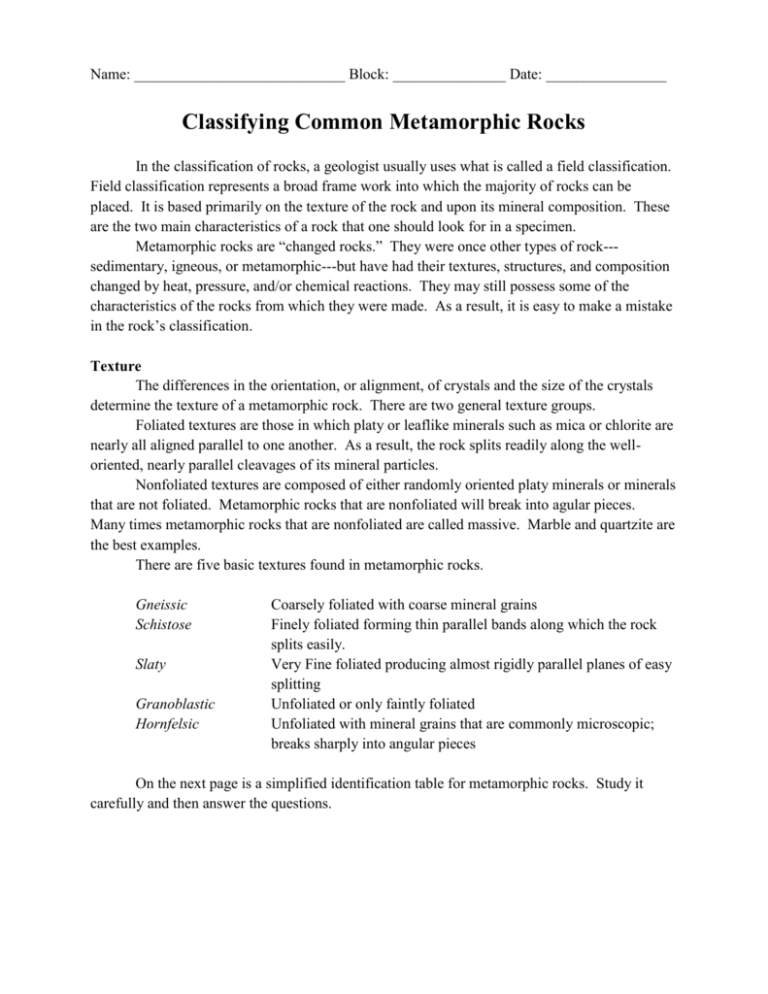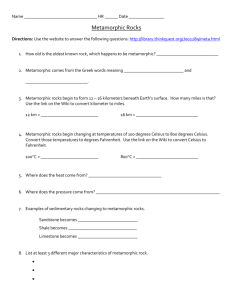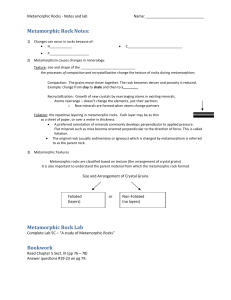Classifying Common Metamorphic Rocks
advertisement

Name: ____________________________ Block: _______________ Date: ________________ Classifying Common Metamorphic Rocks In the classification of rocks, a geologist usually uses what is called a field classification. Field classification represents a broad frame work into which the majority of rocks can be placed. It is based primarily on the texture of the rock and upon its mineral composition. These are the two main characteristics of a rock that one should look for in a specimen. Metamorphic rocks are “changed rocks.” They were once other types of rock--sedimentary, igneous, or metamorphic---but have had their textures, structures, and composition changed by heat, pressure, and/or chemical reactions. They may still possess some of the characteristics of the rocks from which they were made. As a result, it is easy to make a mistake in the rock’s classification. Texture The differences in the orientation, or alignment, of crystals and the size of the crystals determine the texture of a metamorphic rock. There are two general texture groups. Foliated textures are those in which platy or leaflike minerals such as mica or chlorite are nearly all aligned parallel to one another. As a result, the rock splits readily along the welloriented, nearly parallel cleavages of its mineral particles. Nonfoliated textures are composed of either randomly oriented platy minerals or minerals that are not foliated. Metamorphic rocks that are nonfoliated will break into agular pieces. Many times metamorphic rocks that are nonfoliated are called massive. Marble and quartzite are the best examples. There are five basic textures found in metamorphic rocks. Gneissic Schistose Slaty Granoblastic Hornfelsic Coarsely foliated with coarse mineral grains Finely foliated forming thin parallel bands along which the rock splits easily. Very Fine foliated producing almost rigidly parallel planes of easy splitting Unfoliated or only faintly foliated Unfoliated with mineral grains that are commonly microscopic; breaks sharply into angular pieces On the next page is a simplified identification table for metamorphic rocks. Study it carefully and then answer the questions. Unfoliated or lightly Folicated Metamorphic Rocks Metamorphic Rock Hornfels Texture Hornfelsic Commonly Derived From Any fine-grained rock Quartzite Sandstone Marble Granoblastic, Fine grained Granoblastic Amphobolite Granoblastic Granulite Granoblastic Limestone, dolomite Basalt, gabbro, tuff (an extrusive igneous rock formed from volcanic ash) Shale, igneous rocks Folicated Metamorphic Rocks Metamorphic Rock Slate Slaty Commonly Derived From Shale, Tuff Phyllite Slaty Slate Schist Chlorite Mica Schistose Gneiss Gneissic Coarsely banded, Highly variable Migmatite Texture Basalt, andesite, tuff, shale Shale, tuff, rhyolite Granite, shale, diorite, mica schist, rhyolite Mixtures of igneous and other metamorphic rocks Refer to the information on the front and the table above to answer the following questions. 1. The classification of rocks is based primarily on _________________________________ and _________________________ composition. 2. Name the five basic textures of metamorphic rocks. a. _________________________________________________________________________ b. _________________________________________________________________________ c. _________________________________________________________________________ d. _________________________________________________________________________ e. _________________________________________________________________________ 3. Name the five most common types of metamorphic rocks. (Hint: check your notes and/or textbook) a. _________________________________________________________________________ b. _________________________________________________________________________ c. _________________________________________________________________________ d. _________________________________________________________________________ e. _________________________________________________________________________ 4. What type or types of rocks would result from the metamorphism of the following rocks? a. limestone _________________________________________________________________ b. sandstone _________________________________________________________________ c. granite ___________________________________________________________________ d. shale ____________________________________________________________________ 5. For each of the following description, indicate the type of metamorphic rock. a. Granoblastic, fine to coarse-grained, composed mainly of calcite, dolomite or both ___________________________________________________________________________ b. Very fine-grained, exceptionally well-foliated rock ___________________________________________________________________________ c. Coarse-grained rock with distinct layers or lenses of different minerals; among the most plentiful of metamorphic rocks ___________________________________________________________________________ d. Very hard, sugary-texture granoblastic rock; very widely distributed; made of interlocking quartz grains. ___________________________________________________________________________ e. Hard unfoliated, very fine-grained rock that breaks into sharp angular pieces ___________________________________________________________________________ Metamorphic Rocks Enrichment Activity Metamorphic Process Use the graph to answer questions about the formation of metamorphic rocks. 1. What is the relationship between rock temperature and depth beneath the surface? ______________________________________________________________________________ 2. At a depth of 10 kilometers, what would the temperature be? __________________________ 3. Between 0 and 10 kilometers, how many degrees per kilometers does the temperature increase? 4. Which metamorphic rock shown forms at the highest temperature? ______________________ 5. Through what general temperature range would you expect schist to form? _______________ 6. How many kilometers beneath the surface does gneiss occur? __________________________ 7. As depth increases, what happens to the temperature at which rock melts? ________________ ______________________________________________________________________________ 8. Suppose you knew that a certain metamorphic rock begins to form at about 300oC. How many kilometers beneath the surface might this rock temperature occur? ________________________ 9. How far beneath the surface does shale metamorphose to slate? ________________________ 10. Metasomatism is described as a process by which metamorphic rocks may gradually change into granite (an igneous rock). At which temperature does metasomatism begin? ______________________________________________________________________________








